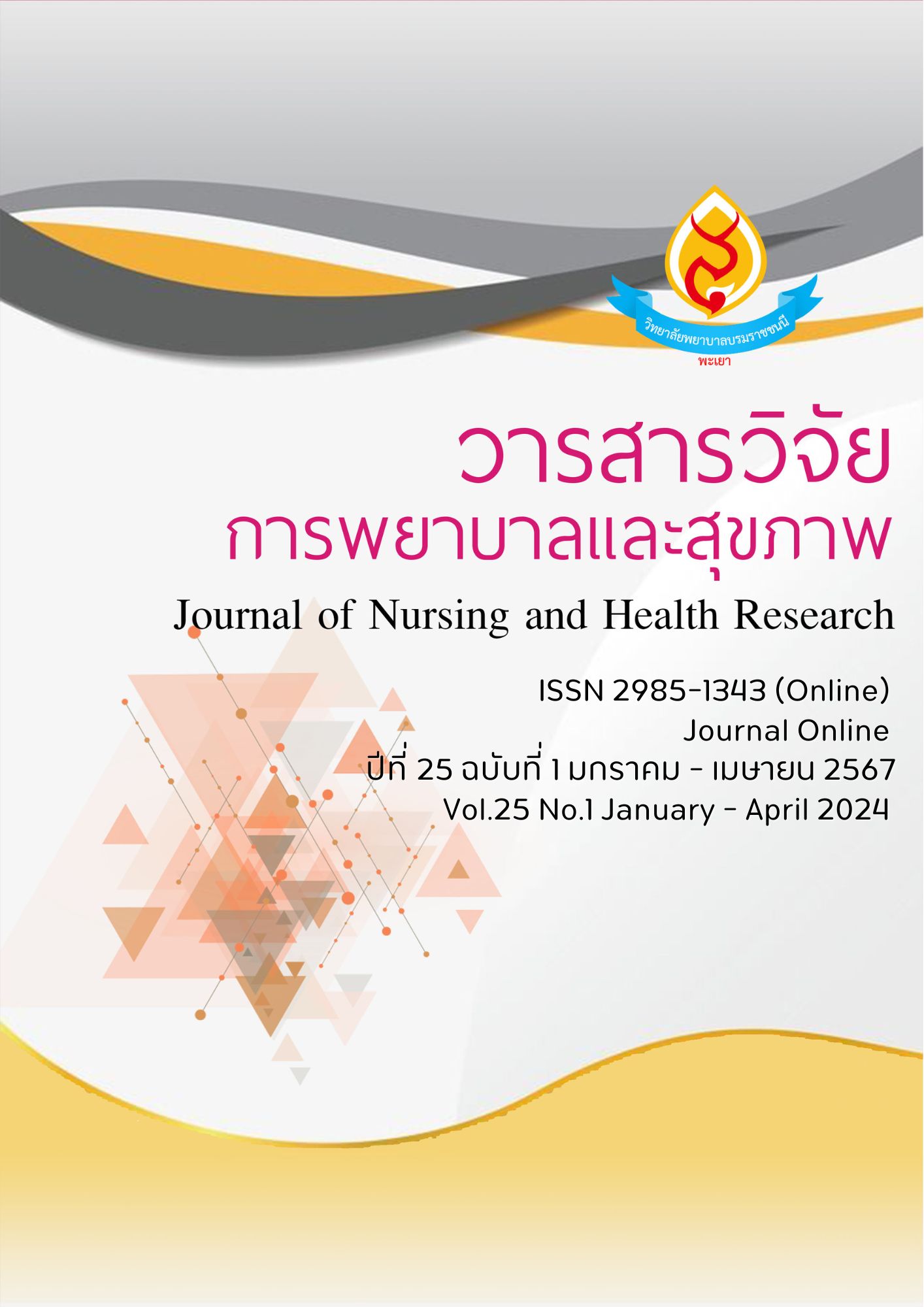ภาวะบีบคั้นทางจิตวิญญาณตามการรับรู้ของวัยรุ่นชายไทยที่มีความคิดฆ่าตัวตาย: การศึกษาเชิงคุณภาพ
คำสำคัญ:
ภาวะบีบคั้นทางจิตวิญญาณ, ความคิดฆ่าตัวตาย, วัยรุ่นเพศชาย, ภาคเหนือบทคัดย่อ
การมีความคิดฆ่าตัวตายและสถานการณ์การฆ่าตัวตายสำเร็จยังคงเป็นปัญหาทางสาธารณสุขที่ทวีความรุนแรงเพิ่มมากขึ้นและเกิดผลกระทบทางลบหลายด้าน ทั้งกับตัวผู้ป่วย ครอบครัว สังคม และประเทศชาติ การวิจัยเชิงคุณภาพแบบบรรยายครั้งนี้มีวัตถุประสงค์เพื่ออธิบายสาเหตุของภาวะบีบคั้นทางจิตวิญญาณตามการรับรู้ของวัยรุ่นชายไทยที่มีความคิดฆ่าตัวตาย เลือกผู้ให้ข้อมูลแบบเจาะจง จำนวน 16 คน เป็นวัยรุ่นเพศชาย อายุ 10-19 ปี ที่เข้ารับการรักษาตัว ที่คลินิกจิตเวชในโรงพยาบาลของรัฐ เขตภาคเหนือ ที่ได้รับการประเมินว่ามีความคิดฆ่าตัวตาย เก็บข้อมูลโดยการสัมภาษณ์เชิงลึก วิเคราะห์ข้อมูลโดยใช้การวิเคราะห์เนื้อหา ผลการศึกษา พบว่า สาเหตุของภาวะบีบคั้นทางจิตวิญญาณตามการรับรู้ของวัยรุ่นชายไทยภาคเหนือที่มีความคิดฆ่าตัวตาย แบ่งได้เป็น 5 ประเด็น ดังนี้ 1) ปัญหาสัมพันธภาพกับบุคคลในครอบครัว 2) ชีวิตไม่มีเป้าหมาย 3) ขาดสิ่งยึดเหนี่ยวจิตใจ 4) ยึดติดกับความล้มเหลวในอดีต และ 5) เหนื่อยล้าจากการเรียน ดังนั้นบุคลากรสุขภาพควรทำความเข้าใจเกี่ยวกับสาเหตุของภาวะบีบคั้นทางจิตวิญญาณจากมุมมองของวัยรุ่นชายไทยในเขตภาคเหนือที่มีความคิดฆ่าตัวตาย และนำไปปรับใช้เพื่อพัฒนารูปแบบบริการสุขภาพที่เหมาะสมและสอดคล้องกับสภาพของปัญหาทางสุขภาพจิตของผู้รับบริการในคลินิกจิตเวชโรงพยาบาลของรัฐ
เอกสารอ้างอิง
กองยุทธศาสตร์และแผนงาน กรมสุขภาพจิต. (2562). แผนพัฒนาสุขภาพจิตแห่งชาติ ฉบับที่ 1 (พ.ศ. 2561-2580). กรุงเทพฯ: กองยุทธศาสตร์และแผนงาน กรมสุขภาพจิต กระทรวงสาธาณณะสุข. เข้าถึงได้จากhttps://omhc.dmh.go.th/img/berry/Slides/%E0%B9%81%E0%B8%9C%E0%B8%99%E0%B8%9E%E0%B8%B1%E0%B8%92%E0%B8%99%E0%B8%B2%E0%B8%89%E0%B8%9A%E0%B8%B1%E0%B8%9A%E0%B9%80%E0%B8%95%E0%B9%87%E0%B8%A1.pdf
บัวหลัน หินแก้ว และ ขนิษฐา นันทบัตร. (2566). ปัญหาและความต้องการการดูแลช่วยเหลือภาวะยากลำบากของผู้สูงอายุในชุมชน. วารสารวิจัยการพยาบาลและสุขภาพ, 24(2), 1-19.
พิมพ์พนิต ภาศรี, กาญจน์สุนภัส บาลทิพย์, อังศุมา อภิชาโต และ อาภรณ์ทิพย์ บัวเพ็ชร. (2564). เป้าหมายชีวิตของนักเรียนในภาคใต้. วารสารพยาบาลสงขลานครินทร์, 41(1), 104-114.
มูลนิธิสถาบันวิจัยและพัฒนาผู้สูงอายุไทย. (2564). สถานการณ์ผู้สูงอายุไทย 2564. กรุงเทพฯ: อมรินทร์พริ้นติ้ง แอนด์พับลิชชิ่ง.
ยุทธชัย ไชยสิทธิ์ และ ประเสริฐ ไพบูลย์รุ่งโรจน์. (2563). การพยาบาลผู้ป่วยที่มีภาวะบีบคั้นทางจิตวิญญาณ. กรุงเทพฯ: สํานักพิมพ์จุฬาลงกรณ์มหาวิทยาลัย.
ศรินรัตน์ วัฒนธรนันท์. (2560). ความโศกเศร้าจากการสูญเสียบุคคลอันเป็นที่รัก: บทบาทพยาบาล. วารสารสภากาชาดไทย, 10(1), 13-21.
ศูนย์เฝ้าระวังป้องกันการฆ่าตัวตาย โรงพยาบาลจิตเวชขอนแก่นราชนครินทร์. (2567). สถานการณ์การฆ่าตัวตายของประเทศไทย ปี 2566 [อินเตอร์เน็ต]. เข้าถึงได้จาก จาก https://suicide.dmh.go.th/news/view.asp?id=92
สมบัติ สกุลพรรณ์. (2562). ศาสตร์เพื่อป้องกันอัตวินิบาตกรรม (การฆ่าตัวตาย) [Vedio]. ThaiMooc. https://lms.thaimooc.org/courses/course-v1:CMU+CMU025+2019/about
สมบัติ สกุลพรรณ์. (2564). การพยาบาลผู้ที่มีพฤติกรรมการฆ่าตัวตาย. เชียงใหม่: สมาร์ท แอนด์ เซอร์วิส.
สำนักงานพัฒนานโยบายสุขภาพระหว่างประเทศ แผนงานพัฒนาดัชนีภาระโรคแห่งประเทศไทย. (2566). การสูญเสียปีสุขภาวะ Disability-Adjusted Life Year: DAYLs รายงานภาระโรคและการบาดเจ็บของประชากรไทย พ.ศ. 2562. นนทบุรี: สำนักงานพัฒนานโยบายสุขภาพระหว่างประเทศ แผนงานพัฒนาดัชนีภาระโรคแห่งประเทศไทย.
Balthip, Q., & Purnell, M. J. (2014). Pursuing meaning and purpose in life among Thai adolescents living with HIV: A grounded theory study. The Journal of The Association of Nurses in AIDS Care/Journal of the Association of Nurses in AIDS Care, 25(4), e27-e38. doi: 10.1016/j.jana.2014.03.004
Guba, E.G. & Lincoln, Y.S. (1989). Fourth generation evaluation. Philadelphia: Sage.
Holloway, I., & Galvin, K. (2023). Qualitative research in nursing and healthcare. John Wiley & Sons.
Hutson, S. P., Darlington, C. K., Hall, J. M., Heidel, R. E., & Gaskins, S. (2018). Stigma and spiritual well-being among people living with HIV/AIDS in Southern Appalachia. Issues In Mental Health Nursing, 39(6), 482-489. doi: 10.1080/01612840.2017.1423426
Kopacz, M. S., Hoffmire, C. A., Morley, S. W., & Vance, C. G. (2015). Using a spiritual distress scale to assess suicide risk in veterans: an Exploratory study. Pastoral Psychology, 64(3), 381-390. doi: 10.1007/s11089-014-0633-1
Machell, K. A., Disabato, D. J., & Kashdan, T. B. (2016). Buffering the negative impact of poverty on youth: the power of purpose in life. Social Indicators Research, 126(2), 845-861.
Martins, H., & Caldeira, S. (2018). Spiritual distress in cancer patients: a synthesis of qualitative studies. Religions, 9(10), 285.
Oman, D., & Lukoff, D. (2018). Mental health, religion, and spirituality. In Oman, D. (Eds). Why religion and spirituality matter for public health: Evidence, implications, and resources, vol 2 (p.225-243). Philadelphia, US: Springer.
Rungsang, B., Chaimongkol, N., Deoisres, W., & Wongnam, P. (2017). Suicidal ideation among Thai adolescents: an empirical test of a causal model. Pacific Rim Internatioanl Journal of Nursing Research, 21(2) 97-107.
Vidya, C., Ganjekar, S., Shalini, C. N., Harish, K., & Murthy, N. S. (2016). Spirituality and its association with psychological distress in cancer patients attending a tertiary care hospital in Bangalore, India. International Journal of Community Medicine and Public Health, 3(7), 1812-1815.
World Health Organization: [WHO]. (2019). Suicide data. from https://www.who.int/mental_health/prevention/suicide/suicideprevent/en/
World Health Organization: [WHO]. (2023). Suicide. From https://www.who.int/news-room/fact-sheet
s/detail/suicide
ดาวน์โหลด
เผยแพร่แล้ว
รูปแบบการอ้างอิง
ฉบับ
ประเภทบทความ
สัญญาอนุญาต
ลิขสิทธิ์ (c) 2024 วารสารวิจัยการพยาบาลและสุขภาพ

อนุญาตภายใต้เงื่อนไข Creative Commons Attribution-NonCommercial-NoDerivatives 4.0 International License.



